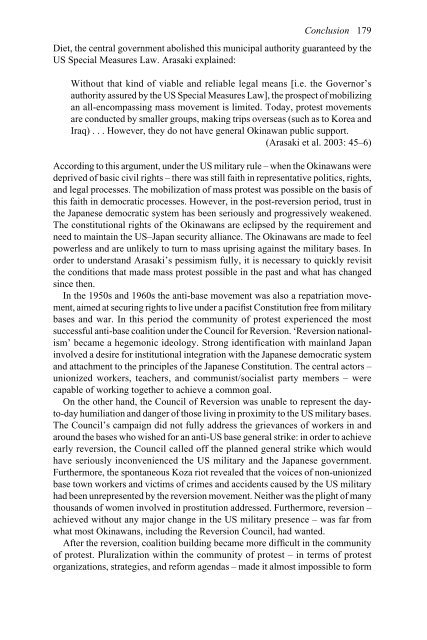Myth, Protest and Struggle in Okinawa
Myth, Protest and Struggle in Okinawa
Myth, Protest and Struggle in Okinawa
Create successful ePaper yourself
Turn your PDF publications into a flip-book with our unique Google optimized e-Paper software.
Conclusion 179<br />
Diet, the central government abolished this municipal authority guaranteed by the<br />
US Special Measures Law. Arasaki expla<strong>in</strong>ed:<br />
Without that k<strong>in</strong>d of viable <strong>and</strong> reliable legal means [i.e. the Governor’s<br />
authority assured by the US Special Measures Law], the prospect of mobiliz<strong>in</strong>g<br />
an all-encompass<strong>in</strong>g mass movement is limited. Today, protest movements<br />
are conducted by smaller groups, mak<strong>in</strong>g trips overseas (such as to Korea <strong>and</strong><br />
Iraq) . . . However, they do not have general Ok<strong>in</strong>awan public support.<br />
(Arasaki et al. 2003: 45–6)<br />
Accord<strong>in</strong>g to this argument, under the US military rule – when the Ok<strong>in</strong>awans were<br />
deprived of basic civil rights – there was still faith <strong>in</strong> representative politics, rights,<br />
<strong>and</strong> legal processes. The mobilization of mass protest was possible on the basis of<br />
this faith <strong>in</strong> democratic processes. However, <strong>in</strong> the post-reversion period, trust <strong>in</strong><br />
the Japanese democratic system has been seriously <strong>and</strong> progressively weakened.<br />
The constitutional rights of the Ok<strong>in</strong>awans are eclipsed by the requirement <strong>and</strong><br />
need to ma<strong>in</strong>ta<strong>in</strong> the US–Japan security alliance. The Ok<strong>in</strong>awans are made to feel<br />
powerless <strong>and</strong> are unlikely to turn to mass upris<strong>in</strong>g aga<strong>in</strong>st the military bases. In<br />
order to underst<strong>and</strong> Arasaki’s pessimism fully, it is necessary to quickly revisit<br />
the conditions that made mass protest possible <strong>in</strong> the past <strong>and</strong> what has changed<br />
s<strong>in</strong>ce then.<br />
In the 1950s <strong>and</strong> 1960s the anti-base movement was also a repatriation movement,<br />
aimed at secur<strong>in</strong>g rights to live under a pacifist Constitution free from military<br />
bases <strong>and</strong> war. In this period the community of protest experienced the most<br />
successful anti-base coalition under the Council for Reversion. ‘Reversion nationalism’<br />
became a hegemonic ideology. Strong identification with ma<strong>in</strong>l<strong>and</strong> Japan<br />
<strong>in</strong>volved a desire for <strong>in</strong>stitutional <strong>in</strong>tegration with the Japanese democratic system<br />
<strong>and</strong> attachment to the pr<strong>in</strong>ciples of the Japanese Constitution. The central actors –<br />
unionized workers, teachers, <strong>and</strong> communist/socialist party members – were<br />
capable of work<strong>in</strong>g together to achieve a common goal.<br />
On the other h<strong>and</strong>, the Council of Reversion was unable to represent the dayto-day<br />
humiliation <strong>and</strong> danger of those liv<strong>in</strong>g <strong>in</strong> proximity to the US military bases.<br />
The Council’s campaign did not fully address the grievances of workers <strong>in</strong> <strong>and</strong><br />
around the bases who wished for an anti-US base general strike: <strong>in</strong> order to achieve<br />
early reversion, the Council called off the planned general strike which would<br />
have seriously <strong>in</strong>convenienced the US military <strong>and</strong> the Japanese government.<br />
Furthermore, the spontaneous Koza riot revealed that the voices of non-unionized<br />
base town workers <strong>and</strong> victims of crimes <strong>and</strong> accidents caused by the US military<br />
had been unrepresented by the reversion movement. Neither was the plight of many<br />
thous<strong>and</strong>s of women <strong>in</strong>volved <strong>in</strong> prostitution addressed. Furthermore, reversion –<br />
achieved without any major change <strong>in</strong> the US military presence – was far from<br />
what most Ok<strong>in</strong>awans, <strong>in</strong>clud<strong>in</strong>g the Reversion Council, had wanted.<br />
After the reversion, coalition build<strong>in</strong>g became more difficult <strong>in</strong> the community<br />
of protest. Pluralization with<strong>in</strong> the community of protest – <strong>in</strong> terms of protest<br />
organizations, strategies, <strong>and</strong> reform agendas – made it almost impossible to form
















